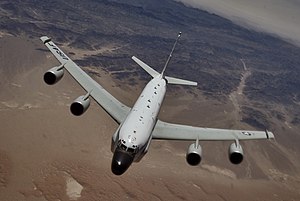Boeing RC-135
| RC-135 | |
|---|---|
 |
|
| An RC-135 Rivet Joint reconnaissance aircraft moves into position behind a KC-135 Stratotanker for aerial refueling. | |
| Role | Reconnaissance aircraft |
| Manufacturer | Boeing |
| Status | Active |
| Primary users |
United States Air Force Royal Air Force |
| Number built | 32 total airframes in all iterations |
| Developed from | C-135 Stratolifter |
The Boeing RC-135 is a family of large reconnaissance aircraft built by Boeing and modified by a number of companies, including General Dynamics, Lockheed, LTV, E-Systems, and L3 Technologies, and used by the United States Air Force and Royal Air Force to support theater and national level intelligence consumers with near real-time on-scene collection, analysis and dissemination capabilities. Based on the C-135 Stratolifter airframe, various types of RC-135s have been in service since 1961. Unlike the C-135 and KC-135 which are recognized by Boeing as the Model 717, the RC-135 is internally designated as the Model 739 by the company. Many variants have been modified numerous times, resulting in a large variety of designations, configurations, and program names.
The first RC-135 variant, the RC-135A, was ordered in 1962 by the United States Air Force to replace the Boeing RB-50 Superfortress. Originally nine were ordered but this was later reduced to four. Boeing allocated the variant the designation Boeing 739-700 but they were modified variant of the KC-135A then in production. They used the same Pratt & Whitney J57 turbojet engines as the tanker variant, but carried cameras in a bay just aft of the nose wheel bay where the forward fuel tank was normally located. They had no refueling system fitted and they were to be used for photographic and surveying tasks.
The next variant ordered was the RC-135B to be used as an electronic intelligence aircraft to replace the Boeing RB-47H Stratojet on ELINT duties. Unlike the earlier variants, the RC-135Bs were fitted with Pratt & Whitney TF33 turbofans rather than the older J57s. These ten aircraft were delivered directly Martin Aircraft beginning in 1965 for installation of their operational electronics suite. By 1967, they emerged as RC-135Cs and all entered service that year. The refueling boom was not fitted and the boom operator station was used as a camera bay for a KA-59 camera. Externally, the aircraft were fitted with sideways looking airborne radar (SLAR) antenna on the lower forward fuselage.
...
Wikipedia
